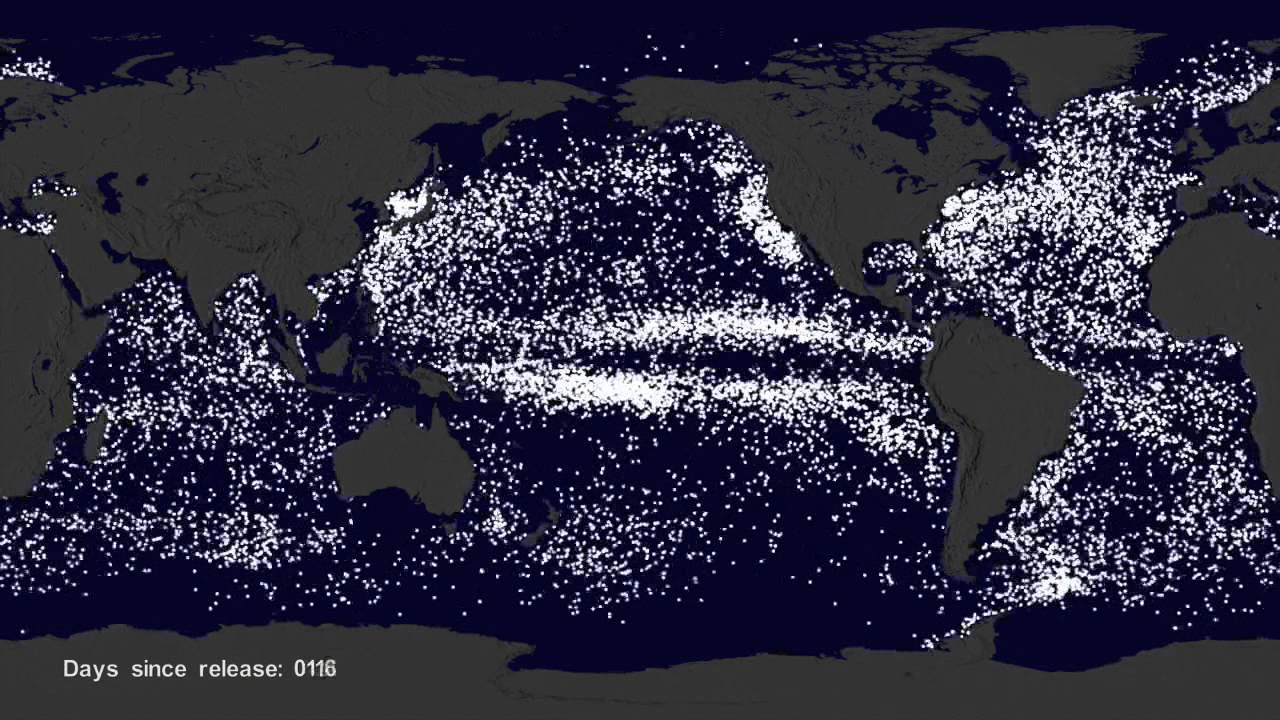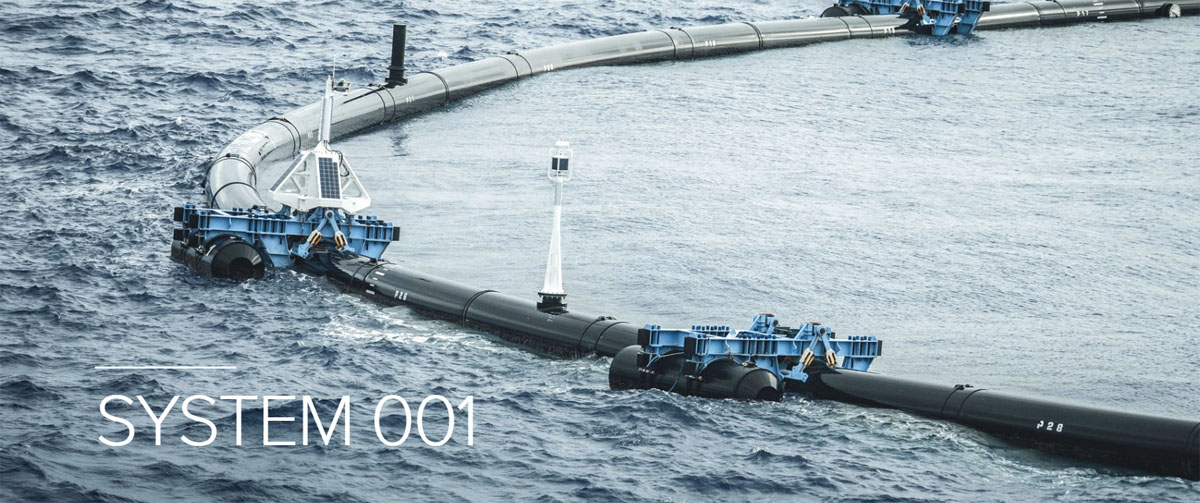Launched the biggest project for cleaning the world's oceans

Despite the opinions of many skeptics (for example, Artemy Lebedev ), the Great Pacific Trash Bin really exists. It can not be seen from space and it is difficult to see the human eye. This is not a floating island of garbage that can be poked with a foot or which looks like a dump. But from this harm to ecosystems is not reduced. Plankton is massively dying, and potentially, under the confluence of certain conditions, we can get a problem worse than Global Warming.
But an 18-year-old boy from the Netherlands decided that it was not worth it. And, with the support of thousands of volunteers and several IT billionaires, he organized a global project, Ocean Cleanup, which has recently moved into an active phase. The goal is to remove half of the Big Garbage Bin over the coming years.
What now
The garbage patch in the Pacific Ocean has grown to an area comparable to India. Its center, the most polluted area, is estimated at 1.6 million square kilometers, and the periphery is another 3.5-4.5 million. This is more than one hundred million tons of garbage that floats close to the surface.
Of course, these are not floating solid plastic bags, as is often the case (the number of such large objects is no more than a thousand per 1 km 2 ). Basically - these are small pieces, the size of a cube of chewing gum, or less. There are already more such “cubes”. In the most polluted areas - three per cubic meter, or 77,000 pieces per 1 km 2 of surface area. All in all, in the "spot" floats about a hundred billion pieces of such plastic garbage.

NASA Simulation ( here’s another good visualization from New Zealand Geographic)
But the main danger is concentrated in microparticles. Those who are not physically discerned by human eyes. Such pieces can be eaten by zooplankton. Fish larvae, small mollusks, crustaceans and other tiny inhabitants of the ocean, which make up the majority of the “population” of our planet. "Zooplankton", absorbing our plastic, die or get sick, animals feeding on plankton suffer from this, and then, along the food chain, almost all creatures of the hydrosphere and biosphere, including humans.
Phytoplankton, unicellular algae and cyanobacteria suffer from plastic less, but there is also a large negative effect. Transparent particles gradually increase the temperature of the water, create greenhouse conditions, and a rise in temperature interferes with the normal development of algae. Fortunately, most of the phytoplankton just because of their dislike for the heat swims a little north of the trash. But nothing prevents them from colliding once, which can cause an ecological catastrophe of unprecedented proportions.
Ocean cleanup
One boy, Boyan Slat, a Dutch inventor, volunteered to fight this. Being engaged in diving in Greece, he understood that there are more plastic bags in the sea than jellyfish. He dropped out of college (majoring in Aerospace Engineering) and organized the Ocean Cleanup project, inventing a simple cleaning system for the seas and oceans. In 2013, at the age of 18, he was able to attract other enthusiasts, and received a grant of $ 100,000 from PayPal founder Peter Thiel (the grant is given to young students who drop out of school to start their own projects).

Slat was able to attract another $ 2 million due to crowdfunding, and with the active help of volunteers in 2015, he launched the first stage of Ocean Cleanup. For such a large and ambitious project, which, in the end, wants to clean up the world's oceans, this was a preliminary step: to collect all the information. Find out how the stain spreads, what kind of garbage floats there, how to collect it most efficiently and where it is worth running the system first.
And the other day, after three years of collecting money and improving technology, the second, main phase of the project finally started. A large floating waste collection system was launched in San Francisco Bay. The first goal is a large clot between California and Hawaii.

In the near future, dozens more are planned to be launched, and in the future, hundreds of other such “floating pontoons” will be launched to different points of the Pacific Ocean. Each of them will have to collect 70 tons of plastic per year, plying in the direction of currents. Boyan expects that as they gain experience, the platforms will improve, and their speed will increase, and the impact on ecosystems will decrease.

So far, there are plans to collect 50% of plastic in the Great Pacific Garbage Patch by 2023, and 90% of plastic - by 2040. In principle, a very good pace, especially considering that Boyan Slat used to expect to launch his system only in 2020.
How it will work
Development Slata - autonomously floating pontoons, connected by pipes 600 meters long. They move in the same way as trash along ocean currents. But unlike the pieces of plastic that float under the surface, the waves are helped by the waves and the wind, due to which they still move a little faster. Below them, in the water - three meters of special dense fabric, which collects plastic. Fishes and other sea creatures move under this “skirt” (they feel that an obstacle is in front), and plankton is calmly carried away by water.

Assembly "skirts"
The system, "abandoned" in the ocean, automatically becomes a semicircle under the influence of currents, so that all the garbage is collected inside. It also independently reorients as it moves - and, accordingly, floats to where there will be more garbage. So that the ship did not collide with it at night, solar-powered lights were installed around the perimeter. If there is an unforeseen large object ahead (say, a tree or an abandoned boat) - the pontoon reacts and tries to slowly change course. It also has various sensors and detectors to collect information on the cleaning progress, and along the edges are two satellite antennas that send signals to the Ocean Cleanup headquarters.
When the platform has collected enough plastic, a ship picks up trash for the subsequent sorting, cleaning and recycling on the shore. This should be done every 3-6 weeks.
The launch of System 001 cost $ 25 million. This includes design, development, production, assembly and testing. The project receives monetary support from the same Peter Thiel, Mark Benioff (co-founder of Salesforce) and thousands of volunteers who also help in developing the system, assembling and sorting plastic.

Ocean Cleanup hopes that other corporations and philanthropists, inspired by their example, will also join the cause - for example, by launching their own platforms. They are also ready to place on the pipes the logos of companies or the names of people who helped with financing, plus - in the project an application for smartphones, from which it will be possible to watch how the “your” pontoon moves, and how much garbage it collects.
Too superficially!
The project, as is usually the case, had many critics. The main argument is that Boyan Slat, literally, thinks too superficially. Millions of tons of plastic will simply pass under the system. Part - under the influence of waves, part - simply because some particles float deeper than three meters.

Ocean Cleanup responds to this criticism that it is impossible to do longer than their “skirt” - it can damage the fish, they simply won’t understand where to escape. And if part of the plastic passes under the platform along with the wave - so nothing prevents you from walking through the same place again. Fortunately, their floating system is self-sufficient, and does not consume any fuel. And the biggest pieces of plastic are always collected from the first pass, so that, at least, their degradation and the formation of new dangerous microparticles stops.

Another problem - Boyan is told that he is too ambitious and unrealistic. Considering how much new plastic is in the ocean every year, and how many such “garbage spots” (in the Pacific Ocean there are several, and in the Atlantic two, and in the Indian large is formed), several dozen floating systems of 600 meters each each is a chicken for laughter. Here we need a project, at a cost commensurate with the flight to Mars. And not a floating tube worth $ 25 million.
The answer is only the beginning, and the Great Pacific Garbage Patch is the dirtiest and most dangerous. If other projects join Ocean Cleanup, and the system can be made permanent, cleaning all oceans 24/7, 365 days a year, the total amount of garbage will definitely decline. Boyan Slat says:
Yes, solving big problems is rarely easy. We can't walk around the ocean a couple of times, and now, everything will disappear. We all have to work, long and constantly. And to me and to all of us - throwing less garbage where no one cleans up after you.

Other issues that Ocean Cleanup faces so far are more commonplace. In System 001 there were defects, due to which a part of the assembled plastic with large waves still floats back into the ocean. The platform under the winds does not move as fast as previously planned. And still it constantly gets abandoned nets of fishermen. Each such network weighs 1.5 tons, and can damage the system, or at least slow down its movement. In developing and testing the System 001 in San Francisco Bay, this was not taken into account. So far, the problem has been solved by periodically assembling such networks onto a ship - after all, this is also garbage, which actively damages the ecosystem of our oceans.
With all these failures, unconfirmed quality of cleaning and, perhaps, excessive ambitiousness of plans, Ocean Cleanup remains the only project trying to do something with the Big trash can. No other company has a working system capable of operating on such a scale. And if nothing is done, according to the World Economic Forum, by 2050 there will be more plastic in our oceans than fish.
PS For purchases in the US (for example, Christmas gifts) you have Pochtoy.com. Delivery of goods - from $ 11.90 per pound. And all readers of our blog after registration can get a discount of 7% for delivery code HABR.

